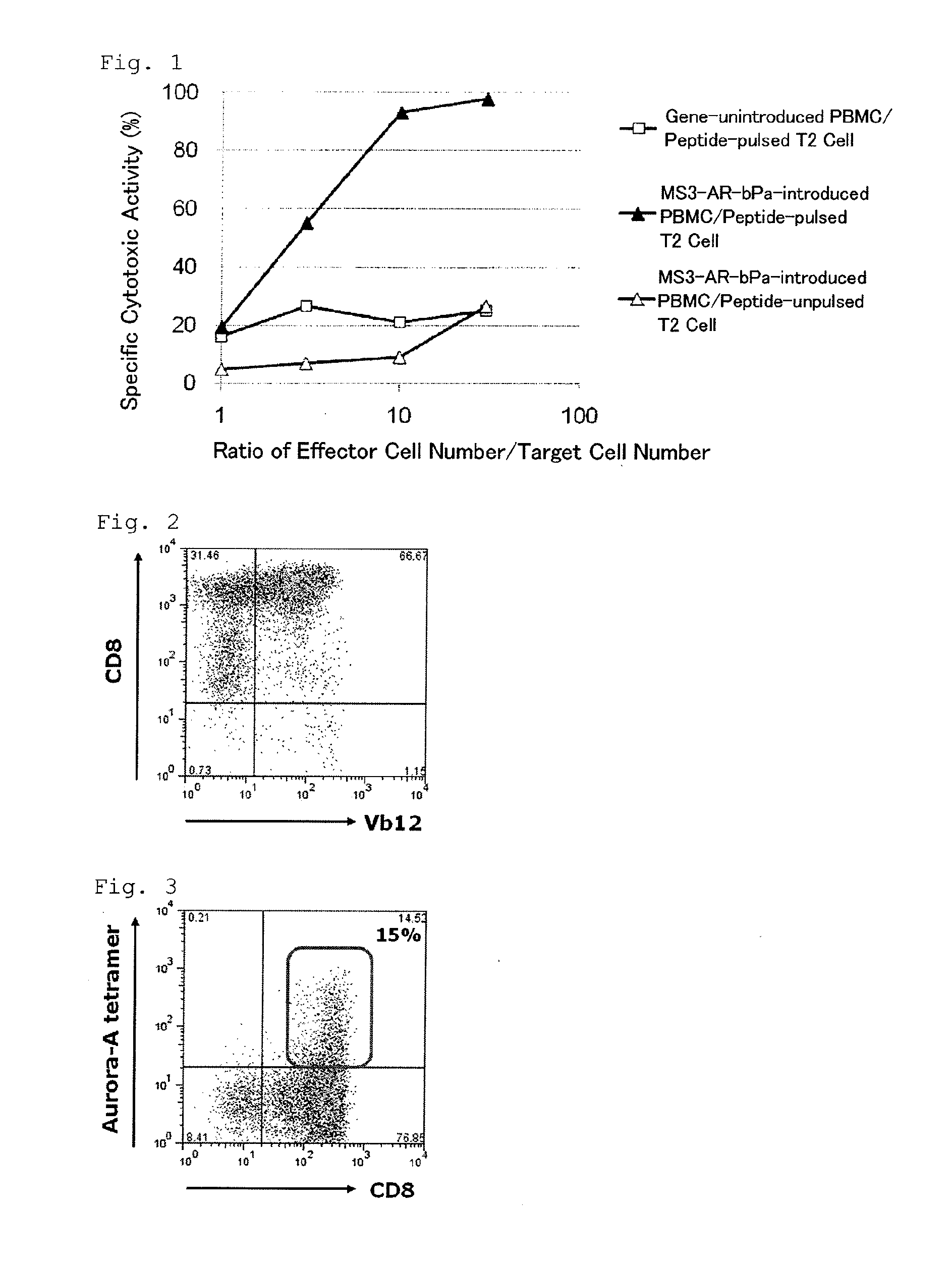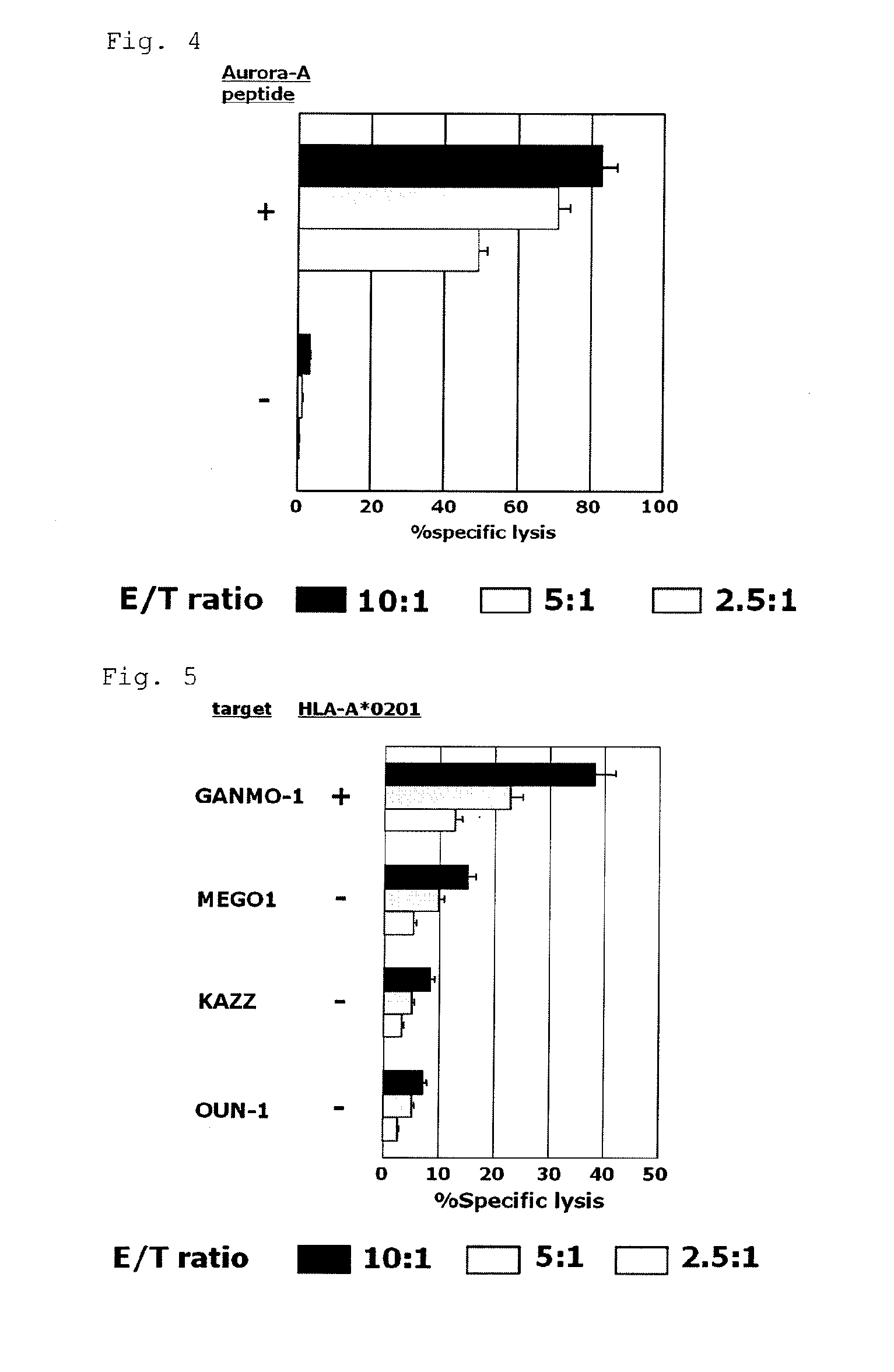T cell receptor and nucleic acid encoding the receptor
- Summary
- Abstract
- Description
- Claims
- Application Information
AI Technical Summary
Benefits of technology
Problems solved by technology
Method used
Image
Examples
example 1
Cloning and Sequencing of TCR α-Chain and β-Chain Genes of Aur-A-Specific CTL Clone AUR-1
[0102](1) Preparation of RNA from AUR-1,5′-RACR, Cloning
[0103]An AUR-1 cell which is a CTL clone exhibiting HLA-A*0201-restricted cytotoxic activity on a target cell pulsed with an Aur-A207-215 peptide (SEQ ID NO: 9 of Sequence Listing, hereinafter, abbreviated as P207) described in Nonpatent Literature 8 was cultured, and RNA was extracted from 2×106 cells using RNeasy Mini Kit (manufactured by Qiagen). Using 400 ng of the RNA as a template, cDNA was synthesized using CapFishing Full-length cDNA Premix Kit (manufactured by Seegene) according to the instruction of the kit. In the reverse transcription reaction, an oligo-dT adaptor set forth in SEQ ID NO: 10 of Sequence Listing, Reverse Transcriptase M-MLV (RNaseH free) (manufactured by TAKARA BIO INC.) and a reaction buffer attached to the aforementioned enzyme were used.
[0104]Using the single-stranded a cDNA thus obtained as a template, PCR was...
example 2
Expression of Aur-A-Specific TCR by Gene Introduction Using TCR α-Chain Gene and β-Chain Gene-Expressing Retrovirus Vector
(1) Construction of TCR α-Chain Gene and β-Chain Gene-Expressing Retrovirus Vector Plasmid
[0107]Using pMSCVneo (manufactured by Clontech) as a template, PCR was performed using a 5′ primer (SEQ ID NO: 15) with a recognition sequence of the restriction enzyme Xho I and a 3′ primer (SEQ ID NO: 16) with a recognition sequence of the restriction enzyme Eco RI, and a 3′-LTR site was amplified, and cut with Xho I (manufactured by TAKARA BIO INC.) and Eco RI (manufactured by TAKARA BIO INC.). The resulting fragments were cloned into the Xho I-Eco RI site of a pMT vector [pM vector described in Gene Therapy, vol. 7, pp. 797-804 (2000)] to prepare a pMT-MS vector. An about 340 bp fragment was obtained by cutting a pMEI-5 vector (manufactured by TAKARA BIO INC.) with the restriction enzymes Mlu I and Xho I and cloned into the Mlu I-Xho I site of the pMT-MS vector to prepar...
example 3
(1) Introduction of Gene into Cell
[0120]GaLV-MS3-AR-bPa retrovirus-infected human CD8-positive lymphocytes were prepared by the same method as in Example 2 (3), and used as TCR gene-introduced human CD8-positive lymphocytes in the following experiment.
(2) Flow Cytometry Analysis of TCR Gene-Introduced Human CD8-Positive Lymphocyte
[0121]After TCR gene-introduced human CD8-positive lymphocytes were reacted with an anti-human CD8 antibody (manufactured by Becton, Dickinson) and an anti-human Vb12 antibody (manufactured by Becton, Dickinson) which specifically recognizes a TCR β-chain V region, flow cytometry analysis was performed. The results are shown in FIG. 2. In FIG. 2, the X axis indicates a human Vb12 positive rate, and the Y axis indicates a human CD8-positive rate. As apparent from FIG. 2, 67% of the human CD8-positive lymphocytes in which the HLA-A*0201-restricted Aurora-A-specific TCR α / β gene of the present invention was introduced were human CD8-positive and human Vb12-pos...
PUM
| Property | Measurement | Unit |
|---|---|---|
| Cytotoxicity | aaaaa | aaaaa |
Abstract
Description
Claims
Application Information
 Login to View More
Login to View More - R&D
- Intellectual Property
- Life Sciences
- Materials
- Tech Scout
- Unparalleled Data Quality
- Higher Quality Content
- 60% Fewer Hallucinations
Browse by: Latest US Patents, China's latest patents, Technical Efficacy Thesaurus, Application Domain, Technology Topic, Popular Technical Reports.
© 2025 PatSnap. All rights reserved.Legal|Privacy policy|Modern Slavery Act Transparency Statement|Sitemap|About US| Contact US: help@patsnap.com



